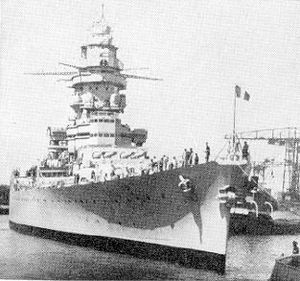 Strasbourg in port
| |
| History | |
|---|---|
| Name | Strasbourg |
| Namesake | City of Strasbourg |
| Ordered | 16 July 1934 |
| Builder | Ateliers et Chantiers de la Loire |
| Laid down | November 1934 |
| Launched | December 1936 |
| Commissioned | 15 September 1938 |
| Fate |
|
| General characteristics | |
| Class and type | Dunkerque-class battleship |
| Displacement | |
| Length | 214.5 m (703 ft 9 in) (loa) |
| Beam | 31.08 m (102 ft) |
| Draft | 8.7 m (28 ft 7 in) |
| Installed power |
|
| Propulsion | 4 Shafts; 4 geared steam turbines |
| Speed | 29.5 knots (54.6 km/h; 33.9 mph) |
| Range | 13,900 km (7,500 nmi; 8,600 mi) |
| Crew | 1,381–1,431 |
| Armament |
|
| Armor |
|
| Aircraft carried | 2 floatplanes |
| Aviation facilities | 1 catapult |
Strasbourg was the second and final member of the Dunkerque class of fast battleships built for the French Navy in the 1930s. She and her sister ship Dunkerque were designed to defeat the German Deutschland class of heavy cruisers that had been laid down beginning in the late 1920s, and as such were equipped with a battery of eight 330 mm (13 in) guns to counter the six 280 mm (11 in) guns of the Deutschlands. Strasbourg was laid down in November 1934, was launched in December 1936, and was commissioned in September 1938 as the international situation in Europe was steadily deteriorating due to Nazi Germany's increasingly aggressive behavior.
Strasbourg was assigned to the Atlantic Fleet upon entering service; her only significant peacetime activities consisted of visits to Portugal in May 1939 and a tour of Great Britain in May and June that year. She spent the next two months training with other units of the fleet and in September, France and Britain declared war on Germany over its invasion of Poland, starting World War II. The two Dunkerque-class ships formed the core of the Force de Raid (Raiding Force), tasked with protecting Allied merchant shipping in the central Atlantic. The unit was quickly divided into two groups, with Strasbourg and other units being detached as Force X, based in Dakar. With an increasingly belligerent Italy threatening to enter the war in April 1940, Force X was recalled to the Mediterranean to act as a deterrent, though the defeat of French forces in the Battle of France rendered the situation moot.
The armistice specified that Strasbourg and the rest of the French fleet would be demilitarized, and she and several other battleships were stationed in Mers-el-Kébir at the time. Mistakenly under the impression that the Germans sought to seize the ships, the British Force H was sent to either force the ships to continue fighting or to destroy them. When the French refused the ultimatum, the British opened fire, but Strasbourg evaded the British and escaped to Toulon. There, she served as the flagship of the newly established Forces de haute mer until the Germans attempted to seize the fleet during Case Anton, leading to its destruction in the scuttling of the French fleet in Toulon in November 1942. The wreck was seized by the Italians, who raised Strasbourg and then started dismantling the ship, and was later taken by the Germans. The vessel was bombed and sunk a second time by American bombers in August 1944, and was sold for scrap in 1955.